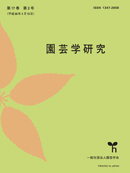Volume 20, Issue 4
Displaying 1-13 of 13 articles from this issue
- |<
- <
- 1
- >
- >|
REPORTS
Breeding & Germplasm Resources
-
Genetic Relationship and Introduction Pathways of Eggplant Cultivars Originating in Akita Prefecture2021Volume 20Issue 4 Pages 379-385
Published: 2021
Released on J-STAGE: December 31, 2021
Download PDF (2738K) -
2021Volume 20Issue 4 Pages 387-397
Published: 2021
Released on J-STAGE: December 31, 2021
Download PDF (9533K) -
2021Volume 20Issue 4 Pages 399-406
Published: 2021
Released on J-STAGE: December 31, 2021
Download PDF (3418K)
Crop Production & Cropping Type
-
2021Volume 20Issue 4 Pages 407-413
Published: 2021
Released on J-STAGE: December 31, 2021
Download PDF (1435K) -
2021Volume 20Issue 4 Pages 415-422
Published: 2021
Released on J-STAGE: December 31, 2021
Download PDF (1377K) -
2021Volume 20Issue 4 Pages 423-432
Published: 2021
Released on J-STAGE: December 31, 2021
Download PDF (1333K) -
2021Volume 20Issue 4 Pages 433-443
Published: 2021
Released on J-STAGE: December 31, 2021
Download PDF (5422K)
Growth Regulation
-
2021Volume 20Issue 4 Pages 445-453
Published: 2021
Released on J-STAGE: December 31, 2021
Download PDF (9004K)
Postharvest Physiology & Technology
-
2021Volume 20Issue 4 Pages 455-461
Published: 2021
Released on J-STAGE: December 31, 2021
Download PDF (2728K) -
2021Volume 20Issue 4 Pages 463-468
Published: 2021
Released on J-STAGE: December 31, 2021
Download PDF (4241K) -
2021Volume 20Issue 4 Pages 469-475
Published: 2021
Released on J-STAGE: December 31, 2021
Download PDF (5994K)
NEW TECHNOLOGY
-
2021Volume 20Issue 4 Pages 477-486
Published: 2021
Released on J-STAGE: December 31, 2021
Download PDF (1317K)
NEW CULTIVAR
-
2021Volume 20Issue 4 Pages 487-494
Published: 2021
Released on J-STAGE: December 31, 2021
Download PDF (1123K)
- |<
- <
- 1
- >
- >|
